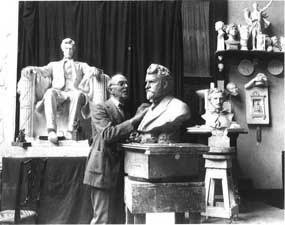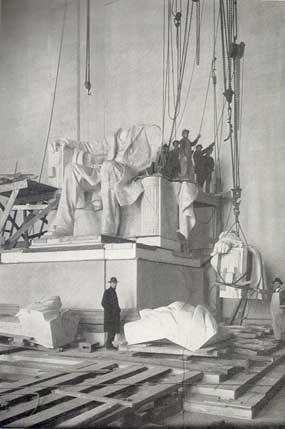Jules Guerin
The artist that architect Henry Bacon hired to create watercolor illustrations of his proposed Lincoln Memorial architectural and landscape concepts. Born in St Louis, Missouri a year after the end of the Civil War, Guerin later studied art in Chicago and Europe. Throughout the late nineteenth and early twentieth centuries, he exhibited his work at many of the great celebratory expositions such as the 1901 Pan American in Buffalo, New York and the 1904 Louisiana Purchase in St. Louis.
As the memorial emerged, Bacon selected Guerin to decorate the Lincoln Memorial interior with two canvas murals, each 60 feet long by 12 feet high, and weighing 600 pounds. Together, the murals visually symbolize the resounding principles of Abraham Lincoln. These allegorical renderings also emphasize the two great accomplishments of Abraham Lincoln’s presidency—Emancipation and Unity.
“Emancipation”, above the Gettysburg Address on the south wall, represents Freedom and Liberty. The central panel shows the Angel of Truth releasing slaves from the shackles of bondage. The left panel of the mural represents Justice and Law. The right panel represents Immortality. Surrounding the central figure are Faith, Hope, and Charity.
“Unity”, above the Second Inaugural Address on the north wall features the Angel of Truth joining the hands of two figures representing the North and South. Her protective wings cradle the arts of Painting, Philosophy, Music, Architecture, Chemistry, Literature, and Sculpture. Emerging from behind the music figure is a veiled image of the Future. The left group represents Fraternity while the right group represents Charity. On the Unity mural, the fourth figure from the left of the Angel of Truth is the head of Lincoln Memorial architect Henry Bacon.


